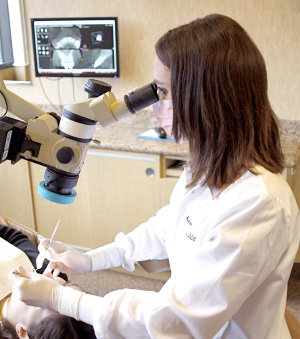Our Services

Specialist Consultation
Often times your dentist will identify a condition with your tooth that he or she is uncertain of the best course of action. Perhaps it is an old root canal that appears to be re-infected. Or sometimes they see a shadow on the x-ray but they are unsure if it represents disease or if it is just a variation of normal.
Root Canal Treatment
If your pulp or nerve space has become ill, endodontic treatment can be done to relieve you of pain and infection and maintain the natural tooth in the mouth. Root canal treatment can often be performed in one or two visits and involves the following steps…
Root Canal Retreatment
While endodontic treatment, if done properly, has a success rate of over 90%, occasionally bacteria from your mouth can re-contaminate the roots even after a root canal. Many times people think that if a tooth has a root canal it no longer has a nerve so it can’t hurt. This is not always true.
Endodontic (Apical) Surgery
The most common endodontic surgical procedure is called an apical surgery or root-end resection. When inflammation or infection persists in the bony area around the end of your tooth after endodontic treatment, your endodontist may perform an apical surgery if retreatment has not been successful or is not a good option.
Trauma Management
After tooth decay, trauma is the most common reason why a tooth may need a root canal. This is most common in front teeth.
Cracked Tooth Management
Sometimes if a tooth becomes cracked it can develop pain to biting. Other times, it may not hurt at all. Cracks develop in teeth just like they can develop in any other mineralized tissue. Bones can break, and teeth can too!
Incision for Draining
If your tooth has developed an infection and that has started draining into the gum, sometimes an incision for drainage is indicated. This procedure is done to drain the fluid from the infected site and help relieve some of the pressure and pain associated with it.
Internal Bleaching
If a tooth becomes severely discolored, but all of the other adjacent teeth appear normal, we can bleach just that individual tooth! This is called internal bleaching, and the goal is for that tooth to achieve a similar shade to those teeth surrounding it.
Resorption
If your dentist referred you to Dr. Potter because he or she said you have “resorption,” you probably thought, “I have WHAT?”
Location & Contact
665 Camino de los Mares, Suite 204
San Clemente, CA 92673
Map & Directions
Phone: (949) 661-9680
Fax: (949) 661-4872
Email: Contact Us
Office Hours
Mon – Fri: 8am – 5pm






